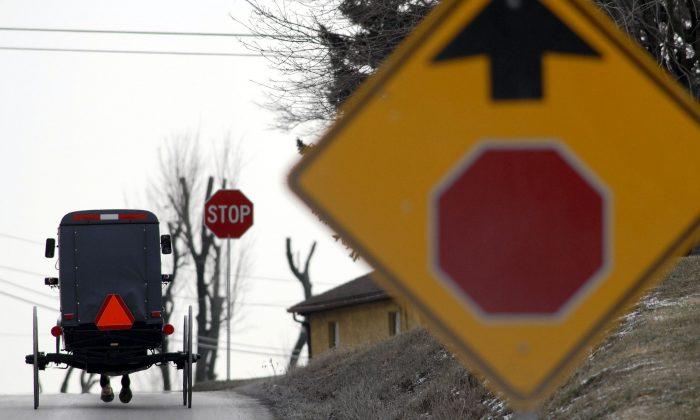For the Old Order Amish of Holmes County, Ohio, the change came slowly on two wheels and with a rechargeable battery.
But in growing numbers, they’re switching from traditional bicycles and push scooters to electric bikes as their daily drivers.
“It’s taken some time. It just kind of slowly caught on,” said David Mullett, 35, owner of E-Bikes of Holmes County, a business he started in 2015.
Among non-Amish—“the English,” as many Amish call them—it may seem odd to see Amish men and women in traditional garb riding e-bikes as opposed to the traditional horse and buggy.
“The most conservative [Amish communities] would not even have traditional bikes,” Mr. Mullett said. “The beliefs haven’t changed. It’s a material rule that’s changed. I think a lot of it started with commuting to work. It gives you more opportunities” to travel.
Mr. Mullett, a member of the Old Order, said Amish people are nothing if not practical—and it is for practical reasons they’re adopting e-bikes for daily commutes.
“Holmes County is a very hilly community with lots of hills on the roads. Climbing a hill with a traditional bike is a lot of physical work,” he said.
Many Amish people found that e-bikes increase their range compared with traditional bicycles.
E-bikes allow them to seek jobs further away from home and arrive at work without even breaking a sweat.
Since e-bikes use an electric motor for propulsion, they require less human energy to operate. So people with physical limitations can also travel further distances with relative ease, Mr. Mullett said.
With advances in battery technology, the range of many e-bikes is up to 100 miles before recharging.
“A lot of people bike to work,” Mr. Mullett said. “It really allowed them to have a job further away if you have to find your transportation. It opened more opportunities for jobs.”
As one of the fastest-growing population groups in the United States, Amish people nationwide currently number around 368,000.
The largest Amish community (87,000) resides in Pennsylvania. In 2021, Holmes County was home to more than 37,000 Old Order Amish children and adults.
The tried and true means of transportation is still by horse and buggy, bicycles, and push scooters.

A selection of electric bicycles at E-Bikes of Holmes County in Ohio. Courtesy of David Mullett
Regarding the use of modern technology, prevailing attitudes among the Amish range from avoiding it as much as possible to adopting it slowly if it doesn’t challenge traditional church beliefs.
Some Amish communities don’t even use electricity as a rule.
“Most Amish churches did not allow [e-bikes],” Mr. Holmes told The Epoch Times. “Every church is responsible for making their guidelines.”
“Being Amish is a way of life. It’s not a religion. Beliefs have not changed.”
Mr. Holmes said his first e-bike was a borrowed model used for commuting to work.
Later, he began retrofitting traditional bicycles with e-bike kits in a small business startup.
It was a “phenomenal kit when we started,” he said.

A horse and buggy on a farm in Lancaster County, Pa., on April 26, 2023. Richard Moore/The Epoch Times
Over the past decade, his e-bike business has grown with two store locations selling eight different brands of e-bikes.
Among the Amish, the “Magnum” brand is in popular demand.
“I grew up riding a bicycle. That was standard for the Holmes County community,” Mr. Mullett said.
“The first time you ride [an e-bike] makes our job really enjoyable—the smiles on people’s faces. Once they ride one, it’s better than they expected.”
However, only some within the Old Order Amish community were quick to embrace e-bikes.
Mr. Mullett said his business encountered criticism at first.

E-Bikes of Holmes County in Ohio. Courtesy of David Mullett
“My encouragement was always to stay within the guidelines of the church,” he said. “If you’re not allowed to have them, don’t get them. It’s the same thing with anything that changes.
“People don’t like change. But as change happens and more people embrace it, it becomes more accepted as well. As we grow, it’s much larger than just this community. We’re not trying to keep this a community business. We’re here to help anyone with e-bike needs.”
Having replacement parts readily available is critical to the business. But once you’ve ridden an e-bike, it’s difficult going back to a traditional bicycle, Mr. Mullett said.
“One of the questions we get a lot is how do you charge the device. One of the answers is at work or for solar power at their place of residence.”
Adoption of solar power is another changing aspect of Amish life that’s “just as popular as the electric bike,” he said.
He said that’s because many Amish people prefer to live independently and off the grid.”
Many Amish people choose to use solar power because it aligns with their religious beliefs.
“The Amish believe that using solar power is using God’s natural resources in the most responsible way possible,” according to Discoversolarpower.com.
“Solar power is a renewable energy source that’s been gaining popularity in recent years. For the Amish, who value simplicity and self-sufficiency, solar electricity is an appealing option.”

An employee at E-Bikes of Holmes County in Ohio works on an e-bike. Courtesy of David Mullett
An estimated 80 percent of the Amish in Holmes County use solar panels to power their homes. And while some still resist adopting renewable energy options, “even some of the more orthodox Amish are excited about the incorporation of solar power,” reports seveonenergy.com.
Mr. Mullett said that e-bike use in Holmes County “evolved” and that many Amish still use the horse and buggy to go to Sunday church services.
Slowly but surely, he’s seen their interest in e-bikes grow over the past eight years.
“It’s been a fun ride,” Mr. Mullett said.







